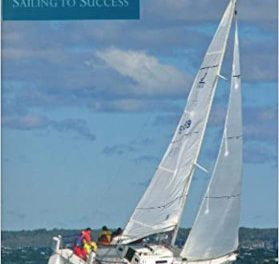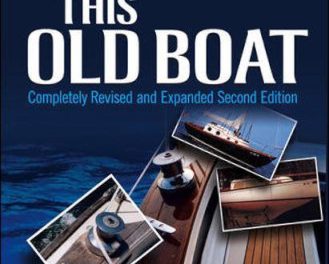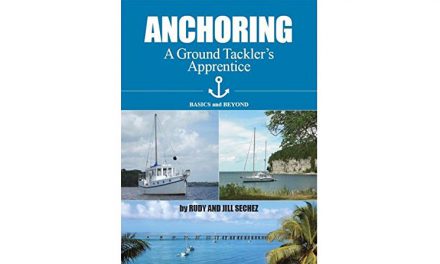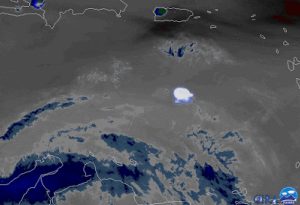 CARIBBEAN EXPLOSION
CARIBBEAN EXPLOSION
I wonder if any sailor readers in the Caribbean saw this on June 22: earthsky.org
–Gregg Bruff, Good Old Boat contributor and reader
Thanks Gregg. We didn’t see this but found reading about it fascinating. For example, this happens, on average, once or twice a year? And this is only the fourth time in history that a non-manmade impacting object was observed prior to atmospheric entry? We’ll keep our eyes open. –Eds.
REVISITING THE ELIQUIS BOAT
I ran across your discussion about the Eliquis boat (May issue of The Dogwatch). I own a Farr 740 (one of only 2 in the US that I am aware of) and the boat in the commercial has many of the design features of the Farr 740. The original Sea Nymph (New Zealand built) 740s had a wrap-around window cover (over 4 small windows) and rigging that had the stays in line with the mast and running backstays. Later boats had more conventional swept-back spreaders and no running backstays. The original Sea Nymph molds were destroyed in the 90’s, but a slightly modified and updated version was (is?), built under license in Italy. Those boats have more conventional window configurations; it may well be the boat in the commercial. As for the “T” number, I have seen them on F740 sails as a racing ID similar to PHRF #s. Here is a link to several photos and the sales brochure for the Italian boats: http://www.sailingtheweb.com/sailboats/Farr+740+Sport/Plastivela
The Farr 740 shares the design concept of the S2 7.9 Grand Slam and the Santana 23D, a shallow lightweight dingy-style hull with a ballasted daggerboard, reasonable cruising accommodations, and a large cockpit (my boat’s is 8 feet long). I recently weighed my boat with everything on board (including the OB motor) and “ready to sail” she came in at 2750 lbs. All three of these boats rate similar to J24 performance.
–Mike Dawson, Farr 740 Sport, #008
MEGA NUTS?
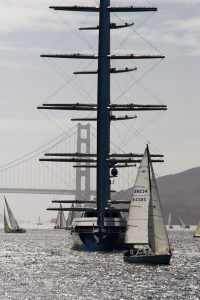
photo by Rick Bucich, linked to copyright license
I love sailing. I’ve been a sailor all my life, since my dad built a 7.5-foot pram dinghy called a Gremlin for my brother and me. We learned to sail in it and then quickly moved on to an 11.5-foot boat called a Heron. From there we graduated to a 17.5-foot cabin cruiser called a Silhouette. Since leaving home, we have each owned numerous boats and we are still, in our 70s, keen sailors and boat owners.
Yet, I find at this age that I am no longer tolerant of obscene wealth reflected in sailing. I no longer admire gorgeous images of mega sailing yachts or supremely high-tech foiling sailing craft that move at over 30 knots. The money required to build and keep these boats could be better spent, particularly in the face of the numerous crises our world faces.
Boat owners who justify this type of expenditure are in denial about climate change and environmental degradation. The unbelievable level of luxury these owners demand is obscene. It gives me reason to reflect on the Christian teaching about how it is harder for a rich man to enter the kingdom of heaven than for a camel to pass through the eye of a needle.
I accept that each person is working out their own salvation the best way they know how. But making these observations (judgments if you like) is part of my way. I feel like someone needs to blow the whistle and shout, “Enough”!
–Andy Vine
We appreciate your sentiment, Andy, but you’re ignoring relativity. We’re willing to bet you’re a rich man. So rich that a couple billion people on this planet could make the same protest about your wealth and its obscenity. A 5-year-old SUV in the garage, a vacation in Hawaii, a modest Catalina 30 at the marina — it wouldn’t take much to give them a valid claim against you on the same grounds. –Eds.
WATER-VULNERABLE ELECTRONICS
In 25+ years of sailing, we’ve not had much luck with expensive boat stuff that was sold as waterproof. Specifically, it’s motorized stuff with circuit boards that get wet and fail when water intrusion happens, stuff like self-switching bilge pumps by Rule and our Torqeedo outboard. We wondered if we were cursed or in good company, so we put it to the readers.
Not to dump on Rule, but we’re going to give Jim Conners the first word… –Eds.
Upon returning my second failed Rule bilge pump with integral switch to the marine store where I purchased it, the store owner told me, “You know, I’ve never sold one of these that didn’t come back.”
–Jim Conners, Sydney, Cape Breton, Nova Scotia
I’ve only owned a boat for 9 years, and so far, the electric submersible bilge pump that I bought near the beginning of that time is still working. I think the previous pump that came with the boat worked too but couldn’t really handle the high lift created by an encapsulated keel.
I’ve had two motion sensing solar lights on my house: one failed, and one still works. I tried to fix the one that failed and couldn’t, so maybe it was the circuit board. These are relatively cheap, non-critical products, so I don’t have very high expectations, but they aren’t disposable either.
I find waterproof phones remarkable. But their market is immense, and the companies need differentiation, so shatter-resistant glass and waterproof are some of the ways they do it, and they charge many times the cost of a bilge pump and move a million times more product. To say they have a bigger R&D budget would be an understatement.
My boat has an electric-propulsion motor, and like most other electric things, I try to keep it dry. Water and electronic circuitry clearly don’t mix and submerging electronics is problematic with the high pressure water exerts. And as you point out, moving parts or penetrations make it harder to seal a casing. I think boating is just a small market that doesn’t see the same effort as other products and it sounds like you are unlucky with some of your equipment.
–Damon Lane
Indeed Damon. We’ll note that we’ve had equally good luck with submersible bilge pumps, the standard kind. What we were talking about was a nearly $300 (2011) high-volume automatic bilge pump. If Rule (and others, such as Atwood) can keep their motors dry, why not the boards? Maybe its for the reasons you state. Or maybe we’ve just been unlucky, we’re a pretty small sample. –Eds.
37 years of building dusk-to-dawn controls [photocell sensors] taught us that water can be hydraulically pumped into a sealed cavity through the pvc jackets of the wires that carry power to the circuit. We learned to pot our circuits to remove the chance of negative atmosphere occurrence and to coat our PCB.
–Mark Young
Thanks Mark. Why aren’t you building bilge pumps and electric outboards? –Eds.

